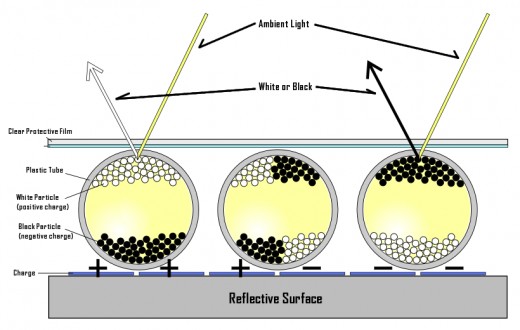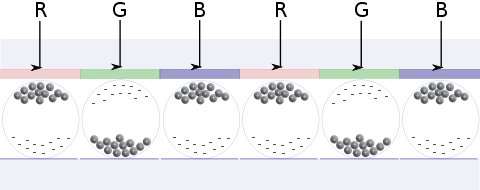eInk! The Amazon Paperwhite Kindle Display
First - Who Is & Who Uses eInk?
eInk is a registered trademark of E-Ink Corporation based in Cambridge, Massachusetts. It is called "electronic paper." Though there is no paper in the true sense of the term. However, it is electronic. As with most computer related terminology electronic paper displays are also referred to by the first letter of each word; EPD.
E-Inc Corp. is currently supplying displays to Sony (eReader), Amazon (Paperwhite Kindle), Ilex (Iliad), Barnes & Noble (nook Simpletouch), Samsung (Alias), and Plastic Logic (Que). The Que features a true page sized (8.5 X 11 inch) screen
Other companies looking at eInk include Texas Instruments, Marvell, Emue, and Epson.

How it works.
Click on the image at right as you read this to get a better understanding of the technology.
Each of the tubes (seen end-on) are smaller than the diameter of a human hair. The tubes are filled with a liquid that holds the particles in the tube in suspension. Note that the liquid is electrically neutral; it is not affected by the charges discussed below.
The white particles are positively charged and the black particles are negatively charged. These charge states for the particles are natural; they do not have to be created in the particles.
When an electric field is applied to the tube the white particles are attracted to negative charges and the black particles are attracted to positive charges. In electricity opposites attract and like charges repulse. Particles naturally migrate to the "top" of the tube or to the "bottom" of the tube depending on what charge is applied at the bottom of the tube.
So, for example, since the white particles are naturally positively charged, if a negative charge is created at the bottom of the tube the white particles move toward the bottom and the black particles move away from the charge. The opposite happens if the charge at the bottom of the tube is positive. In that case the white particles will move away from the charge and the black ones will move toward the bottom.
Applying a positive and negative charge to either side of the bottom of the tube causes both white and black particles to migrate to the top of the tube giving a shade of gray rather than a solid black or white.
Below the tubes and the small plates that carry a charge, e.g. the bottom of the "paper." Below this is a reflective surface. Any ambient (outside source) light is bright enough to make the screen and particles visible.
Because the particles tend to stay where they are once current is shut off, an eInk display uses very little power. In other words power is only used to move the particles around and is not required to keep the particles where they are.
Problems that Had to be Surmounted
A number of problems had to be conquered to bring the world eInk.These are:
- The tubes have to be extremely consistent in diameter while being much thinner in diameter than most human hair. Human hair is 17 to 180 microns in diameter.
- The liquid the particles are suspended in has to be viscous enough to keep the particles where-ever they end up without the need for extra power. It also has to be thick enough to resist the tug of gravity. The fluid is a trade secret
- The black particles have to be very black and have a natural negative charge. The black is a trade secret.
- The white particles have to be very white and have a natural positive charge. Word is the white particles are nano-sized titanium dioxide
Oddly, Amazon's Kindle has received numerous awards and positive critical reviews, but the company that actually makes the displays is largely unknown.
More on eInk Displays
The following are less than ordinary features of eInk:
Pros:
- uses power only when the display is updated
- screens are only twice as thick as ordinary paper
- screens are very flexible and can be rolled up
Cons:
- eInk refreshes very slowly and is not suitable for animation (movies or motion display)
- eInk is gray-scale only; no color as of yet
Interesting Uses
Samsung is now making a smart phone, the Alias2, with an eInk keyboard. The keyboard symbols and underlying functions change with the whatever the user requests of the phone. The keyboard can display just symbols, just numbers, or the standard QWERTY layout most of us are familiar with. This also means that smartphones that are sold in other markets can have keyboards that use the idiograms common to the language of the area they are sold in.
Phosphor is making a curved watch that can be programmed to display various dial configurations. Selectable displays include time in the upper area with a full calendar below. Hour marks at the 12, 3, 6, and 9 marks. With tick marks between. With only the 12 hour displayed and so on.
Polymer Vision has been developing a cell phone with a roll out display. Remember eInk is very flexible and can be rolled or folded. So far the phone has not hit the market.
Seiko attempted to market a bracelet watch. Called the Spectrum it has no band and no clasp; it is a true bracelet. Problem is it has never been marketed...yet.
Delphi, the automotive parts manufacturer for GM has been toying with the idea of a remote control key-fob that can interactively tell you all sorts of things about your car on the fob itself. For example it could show you how much gas you have, whether the car is locked, if any doors are open and so on. Currently the future of this device is in doubt due to the state of the auto industry.
Hitachi was toying with the idea of using eInk on the outside of it's smartphones as a decorative and changeable skin.

Future eInk
EInk Corporation is currently working on color displays. Initial reports are that the surface of the display will carry colored pixels (in the three primary colors) with the particle filled tubes under the surface. These colored pixel squares will be transparent or semi-transparent. This display will work much like the one described above, but the white particles will "shine" through the colored surface creating the pallet of colors we are all used to in color displays. These displays will still have a slow refresh rate.
Disclaimer
The author owns no stock in any of the companies mentioned nor was compensated in any way for this article.









